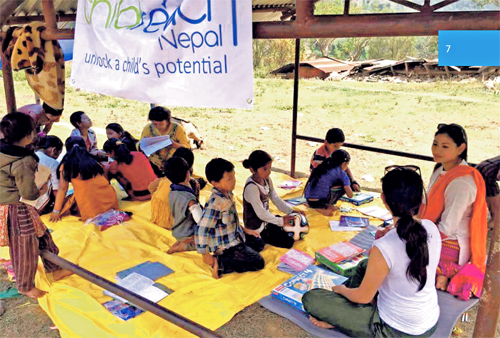Reaching out to the unreached in time of disaster
KATHMANDU, July 18
In response to calls for transparency and accountability in the aid and recovery effort and to drive standards in the humanitarian and development community in the aftermath of the April 25 earthquake, Childreach Nepal is publishing financial breakdown of their emergency response.
Independent Nepali children’s rights organisation, Childreach Nepal, published its financial accounts on its website for the two months following the huge earthquakes that hit Nepal, outlining how they have spent funds donated to their earthquake appeal and the impact of their response.
According to a press release issued by Childreach Nepal, the move comes after the International Conference on Nepal’s Reconstruction held in Kathmandu on June 25, which pledged $4.4 billion for Nepal’s post-earthquake recovery. Senior government officials, including Prime Minister Sushil Koirala, on June 25, two months since the massive quake struck the country that killed 8,800 people and devastated 14 of Nepal’s 75 districts, called for transparency and accountability in the aid and recovery effort.
Calls for openness have also come from Nepal’s civil society and activists who have demanded that lessons are learned from previous natural disasters such as Haiti’s earthquake in 2010. At the recent donor meeting, the European Union listed monitoring of international capital expenditure one of their priorities, whilst the World Bank has highlighted budgetary support as key to the recovery effort.
It is in this context that Childreach Nepal is publishing its accounts for the two-month period immediately following the earthquake, said the release. Since the devastating earthquake struck Nepal on April 25, Childreach Nepal has reached over 2,500 households with emergency aid in Sindhupalchowk district. It has also created 24 temporary learning centres enabling over 4,000 children to continue their education and make them safe from child trafficking and other forms of abuse.
“From the day after the earthquake devastated Sindhupalchowk, where Childreach Nepal has been working for years, we have been at the forefront of relief efforts alongside the Nepali Army and local communities,” said Tshering Lama, Country Director of Childreach Nepal. “The emergency response we undertook has been very challenging, at times life threatening and often overwhelming for all of us. Despite the confusion and chaos after the earthquakes, we were determined to reach those in need, no matter how hard it was to get to them. Being there for the communities of Sindhupalchowk has earned us the respect of the local people and of our supporters within Nepal and abroad.”
As well as getting vital medical supplies, food and shelter to people in Sindhupalchowk, one of the worst affected districts, Childreach Nepal’s team was also able to establish eight medical camps and 24 temporary learning centres for over 4,000 children so their education can continue and they can be safe from traffickers and other potential abuse. “With our partners, we have reached 2,512 households across 18 VDCs, an estimated 10,852 people,” it reported, adding, “Childreach Nepal and Childreach International believe that as a sector we have a duty to be as open about our shortcomings as we are about our successes both for the benefit of those who support us and for the people and children in whose name we operate.”
In numbers
• 18: Village Development Committees Childreach Nepal worked with
• 4,020: Children enrolled in Childreach Nepal’s 24 TLCs
• 2,512: Households reached, the equivalent of approximately 10,852 people
• 2,550: Tarpaulins and tents distributed
• 2,020: Pieces of bamboo distributed for reconstruction
• 800: Patients treated across eight medical camps
• 712: Boxes totaling 19,600 kg food distributed
• 100: Hygiene kits handed out
• 45: Motorcycles mobilised to reach over villages for needs assessments and to deliver emergency supplies






